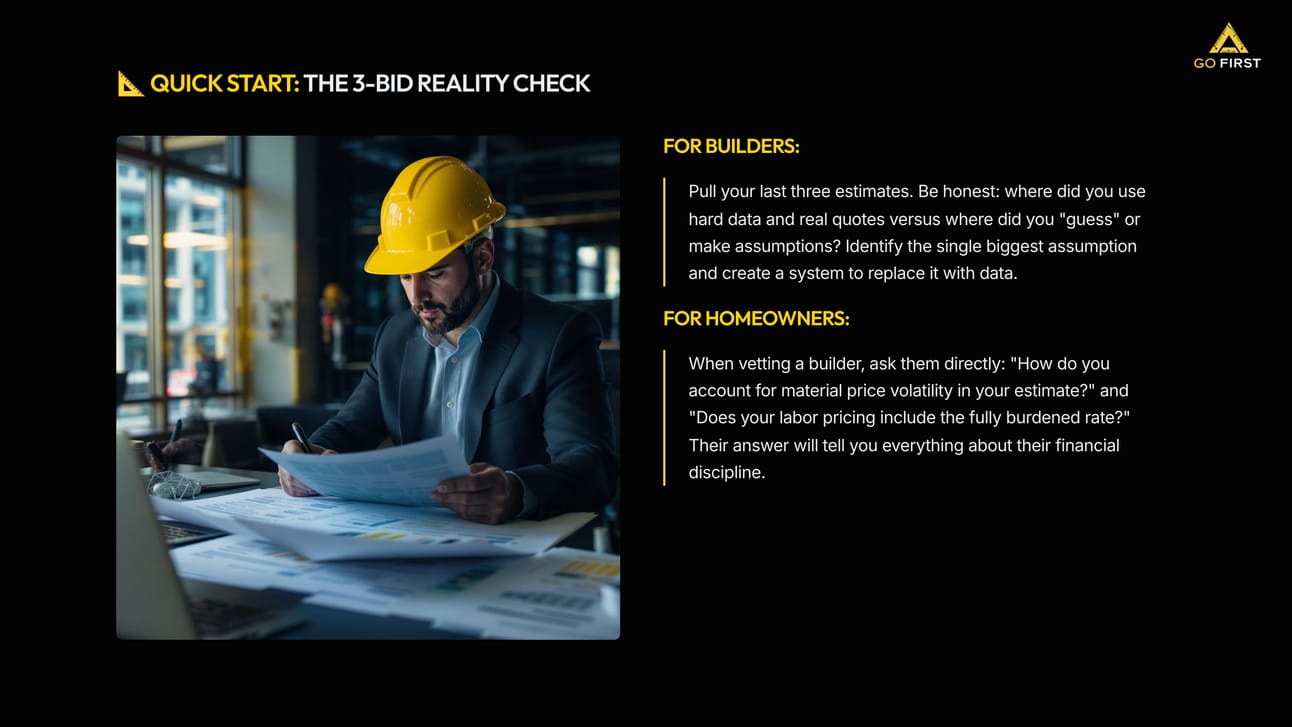Let's cut directly to why so many residential home projects and custom builds blow past their budgets. It's not just a few miscalculations; it's a systemic issue rooted in flawed planning, weak execution, and poor communication. The data is clear: roughly nine out of ten construction projects face cost overruns. For homeowners, this means a stressful experience and an empty wallet. For builders, it means evaporated profits and a damaged reputation.
➡️ This isn't about bad luck. It's about a series of predictable, preventable profit leaks. Understanding where they come from is the first step for both builders and clients to ensure a project is successful and profitable from start to finish.
TABLE OF CONTENTS
⚡ TL;DR (Too Long, Didn’t Read)
FLAWED FOUNDATIONS: Unrealistic budgets, inaccurate estimates, and poorly defined scopes set projects up to fail from day one. Guesswork is not a strategy.
UNCONTROLLED CHAOS: When small changes and client requests aren't formally managed through a change order process, profits and timelines are silently destroyed.
FINANCIAL BLIND SPOTS: You can't fix what you can't see. Without tracking job costs in real-time, builders are flying blind, unable to spot budget issues until it's far too late.

detailed flowchart showing cascading effects of a single construction change order, with multiple branching consequences and timeline impacts, professional diagram
01. THE FLAWED FOUNDATION:
FAULTY PLANNING & ESTIMATING
BLUF: The single biggest cause of a budget overrun happens before a hammer ever swings. It's the silent killer of underbidding and inadequate planning.
Inaccurate Estimates: This is the most common leak.
Guesswork: Relying on memory or old data instead of current, hard costs.
Missing Costs: Forgetting to include the fully burdened labor rate (the true cost of an employee beyond their wage) or failing to allocate enough to cover company overhead.
Ignoring Volatility: Not accounting for fluctuating material prices, which can erase margins overnight.
Poor Scope Definition: When plans or contracts are vague, it leaves the door wide open for interpretation, misunderstandings, and uncontrolled expansion later.
Unrealistic Expectations: Clients often have expectations shaped by home-reno TV shows, not reality. It's the builder's job to educate and align the vision with the budget from the very first conversation.

A construction professional closely examining multiple bid documents, meticulously comparing estimates and making detailed notes in a professional office setting.
02. THE CREEP & THE CHAOS:
POOR SCOPE & CHANGE ORDER MANAGEMENT
BLUF: Even a perfect estimate can be destroyed by a thousand small cuts. This is "scope creep"—the gradual expansion of a project from uncontrolled changes.
Informal Agreements: Performing extra work based on a verbal "go-ahead" is a recipe for disputes and doing work for free.
Underpriced Changes: Rushing to price a change order often leads to forgetting overhead, profit, and the administrative fee, meaning you’re losing money on extra work.
Client Indecision: Delays in client selections for things like tile or fixtures can have a massive ripple effect, disrupting trade schedules and blowing up the timeline.

detailed flowchart showing cascading effects of a single construction change order, with multiple branching consequences and timeline impacts, a professional diagram
03. THE EXECUTION GAP:
OPERATIONAL & FINANCIAL BLIND SPOTS
BLUF: If the plan is the foundation, execution is the frame. Inefficiencies here directly drain the budget.
Inefficient Project Management: Poor scheduling, rushing work, and bad sequencing of trades leads to expensive rework and wasted time on site.
Rework & Warranty: Correcting defects from poor craftsmanship is a silent profit killer. Rework can easily eat up 5% or more of a total project budget.
Lack of Real-Time Job Costing: This is the critical failure. Relying on outdated spreadsheets or waiting for monthly accounting reports means you’re looking in the rearview mirror. By the time you realize a job is going over budget, the money is already gone.

A detailed, high-tech dashboard displaying real-time data on a construction project's labor hours and material costs, presented on a sleek, modern whiteboard.
04. THE BOTTOM LINE
BLUF: Budget blowouts are not inevitable. They are the predictable result of broken or missing systems.
➡️ For homeowners, the key to a successful project is choosing a builder who runs their business with discipline—one who provides a clear scope, manages change formally, and knows their numbers inside and out.
➡️ For builders, moving from "busy and broke" to consistently profitable means declaring war on these profit leaks. It requires implementing robust systems for estimating, change orders, and—most importantly—real-time financial tracking. This is how you build a stronger, more resilient business that gives you back your freedom.

SCHEDULE YOUR STRATEGY
YOUR PATH TO PREDICTABLE PROFITABILITY STARTS HERE.
gofirst.fillout.com/inbound

